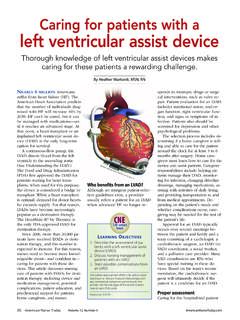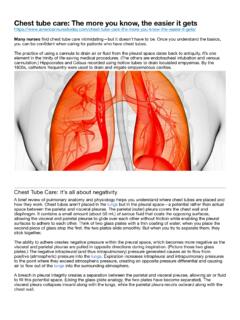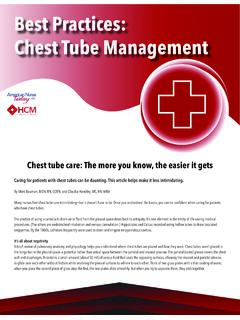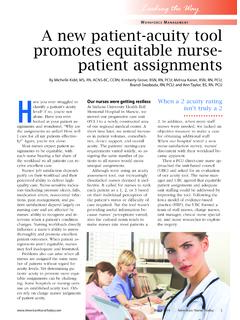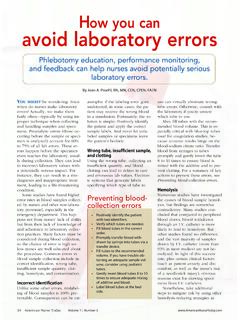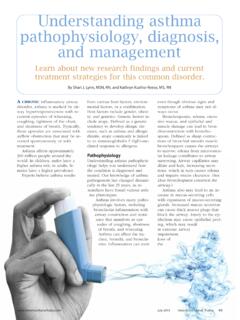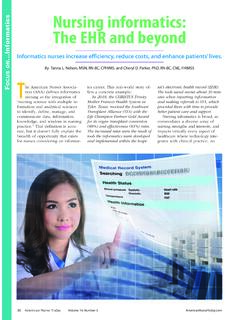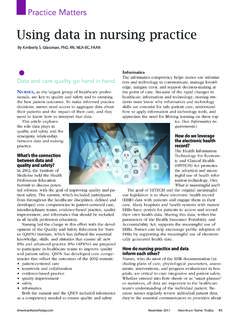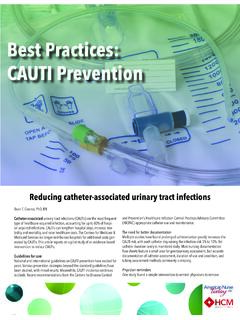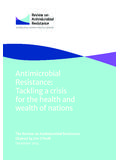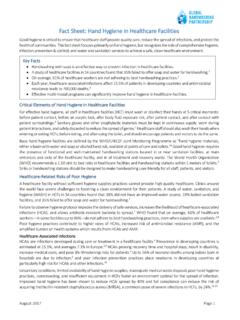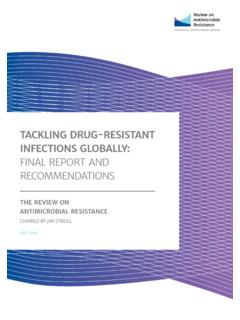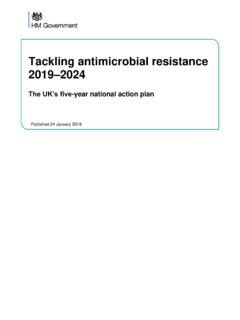Transcription of I.V. Push Medication Administration
1 push Medication Administration Patient safety Best practicesSpecial report to American Nurse Today, supported by an educational grant from Fresenius Kabi USA. 2019, HealthCom Media20 American Nurse Today Volume 14, Number 4 matter of push drug safety Experts weigh in on what nurses need to know. By Catherine Spader, RNNew evidence raises concerns about how nurses are prepar-ing and administering push medications. A 2018 survey published by the Institute for Safe Medication Practices (ISMP) revealed that practi-tioners are frequently using unsafe practices. The 2018 survey is a follow-up to a similar ISMP survey published in 2014.
2 The current survey reveals five major unsafe practices related to push medications that have persisted or worsened in the past decade. (See 5 common unsafe push Medication practices.) Survey participants included 977 clinicians; 93% were nurses and 4% were advanced practice nurses. To shed light on this challenging and multifaceted issue, American Nurse Today is presenting this special section, push Medication Adminis-tration, which focuses on evidence-based practice. The section begins with an overview of the problem from three clinical experts perspectives, fol-lowed by articles on dilution and the myths of push Administration . It concludes with a checklist of key rec-ommendations that nurses can use to ensure they re practicing based on the latest evidence.
3 We asked three clinicians to share their expertise and insight into the issue of push Medication admin -istration: Elizabeth Camp-bell, MSN, RN, CRNI, is past-president of the Infusion Nurses Society New England Chapter and a clinical scholar at Massachusetts General Hospital in Boston. Steven Jarrett, PharmD, is the Medication safe-ty officer in the quality division for Atrium Health in Charlotte, North Carolina. Susan Paparella, MSN, RN, is vice president of the Institute for Safe Medication Prac-tices. Q: What are the concerns about the major findings of the survey? Paparella: In 2015, ISMP published the ISMP Safe Practice Guidelines for Adult push Medications. Despite this, the 2018 survey found wide varia-tions in practice and at-risk behaviors.
4 For example, 66% of survey participants reported using prefilled syringes as vials. This involves drawing Medication from a manufacturer-prepared, ready-to-administer syringe into another sy-ringe. This practice increases the risks of contamination and dosage alter-ation. These products are developed to promote safety, and if you manipu-late them, you re negating that. Campbell: Nurses have been trained about the importance of fol-lowing the five rights of Medication Administration : the right Medication , patient, dose, route, and time. How-ever, the results of this survey show a rise in unsafe Medication practices that fall outside the five rights. The five rights alone aren t going to keep patients safe. It s just as important to administer medications in the right form prepared in the right way.
5 Other-wise, you put patients at risk for com-plications, such as infections, reac-tions, interactions, and Medication errors. therapy can cause many in-juries and complications and is heavily litigated. Jarrett: The elephant in the room is that many nurses aren t following evi-dence-based practice. Rather than using pharmacy dispensed ready-to-adminis-ter, manufacturer-prepared Medication syringes, survey participants report that they re frequently preparing or manip-ulating push medications on pa-tient care units. This practice increases the risk of contamination from bacteria, particulates, and other impurities. Only 50% of participants say they always la-bel self-prepared push medications. Another safety issue is the unneces-sary dilution of push medications.
6 Many nurses also are diluting or re-constituting medications using a pre-filled sodium chloride (saline) flush syringe, which is an unsafe prac-tice. (For more information about dilu-tion, see page 22.) April 2019 American Nurse Today 21Q: Why is there a discrepancy between evidence-based practice and what nurses are doing? Paparella: Nurses don t always have clear direction and policies about di-luting and administering push med i -cations. They may have conflicting refer-ences, learn incorrect information from coworkers, or make up their own meth-ods. They may drift into unsafe behav-iors because they don t perceive the risk or believe that the risk is justified.
7 Campbell: Although nearly every patient admitted to the hospital today has an , insufficient education about and infusion therapy is provided in nursing schools. In addition, when hos-pital budgets get tight, specialized teams may be cut. This can lead to higher rates of complica-tions because of the gap in skill and knowledge between specialist infusion nurses and other nurses. Jarrett: Everyone develops their practice based on their experience, what they were taught, preconceived notions, and what they think is the right thing to do. If nurses aren t aware of any complications, they may feel com-fortable continuing unsafe practices. Another issue is the intermittent shortages of 100 mL bags of nor-mal saline and D5W [5% dextrose in water]. Shortages create confusion about Administration because nurses must give some medications push that they were accustomed to admin-istering via piggyback.
8 Q: How can organizations change unsafe behaviors? Campbell: The infusion world changes quickly with new products, standards, discoveries, and drug shortages. The best thing for patients is to have a dedicated team of experts who are up-to-date on best practices. Educa-tion also needs to go beyond a facili-ty s team. Every unit should have an educated champion who helps en-sure all nurses know best practices. In addition, all incidents of medica-tion infiltration should be document-ed, and managers should hold month-ly staff meetings to discuss issues that have occurred and how to prevent them with safe practices. Paparella: Effecting change is a multilayered process that includes cre-ating awareness, providing the right products, ensuring that managers un-derstand practice guidelines, and ed-ucating nurses about best practices.
9 ISMP guidelines state that facilities should provide push medications in a ready-to-use form as often as possi-ble. This highest-level strategy practice limits the possibility of error. Another tactic is to create easy-to-reference ta-bles that identify the most commonly given push medications, how to ad-minister them, and how to dilute them, if necessary. Organizations also can use the free ISMP Gap Analysis Tool to evaluate their push Medication prac -tices. (See Resources.) Jarrett: Nurses have valid concerns that explain why they do what they do. Listening to their concerns is impor-tant to understand why unsafe prac-tices occur in your setting. Then pres-ent evidence-based standards and the reasons nurses need to follow them. Once you get the evidence out there, nurses will respond.
10 N Catherine Spader is an author and healthcare writer based in Littleton, Colorado. Note: Campbell and Jarrett are members of the Fresenius-Kabi Advisory these resources to learn more about safe Medication Administration practices. Infusion Nurses Society infusion therapy standards of practice: Institute for Safe Medication Practices (ISMP) safe practice guidelines for adult push medications ISMP gap analysis tool for safe push Medication practices: ResourcesThe Institute for Safe Medication Practices (ISMP) published a survey in 2018 that revealed these widespread unsafe push Medication practices: 1 Using prefilled syringes or cartridges as vials (drawing some or all Medication from the prefilled syringe or cartridge into another syringe for Administration ).
